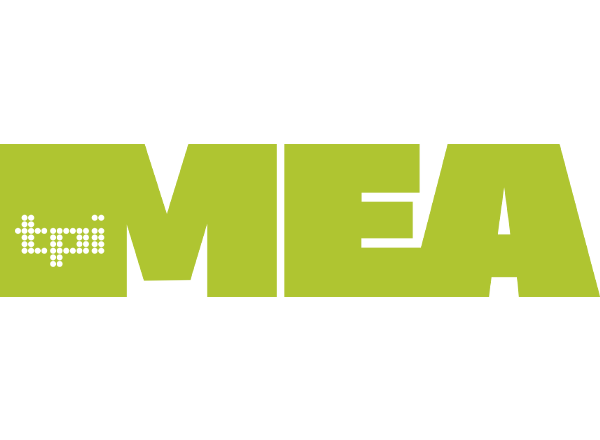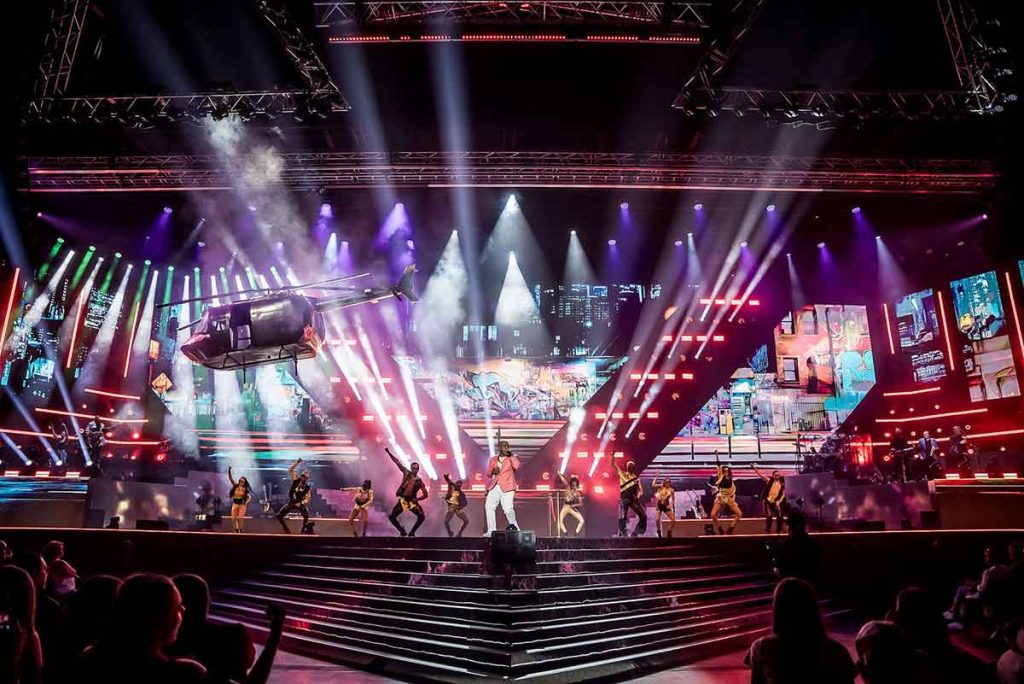With an all-star lineup packed with some of the most popular Afrikaans artists backed by an expert creative and technical team with a genuine passion for the project, it’s no surprise that Afrikaans is Groot (AIG) is one of South Africa’s most popular annual events. A celebration of Afrikaans music and culture, the event has become so popular that last year’s iteration saw nine shows take place over two consecutive weekends, with more than 70,000 people flocking to Pretoria’s SunBet Arena to take in the spectacular cultural experience.
Produced by Coleske Artist Management under the leadership of Technical Director Ian Vos and Creative Producer Barry Pretorius, the show’s set and stage layout were designed by Günther Müller of MGG, which also supplied a turnkey technical solution for the event. “I think I can speak for everyone on the show when I say that AIG is not just another job on the calendar – it’s the one we look forward to every year,” Müller told TPiMEA. “It’s a passion project. We put everything into it, and we reap the rewards with the fulfilling experience it provides for the audience, artists, and crew.”
With AIG celebrating its 10th anniversary in 2024, the event has reached elite status within South Africa and as such it attracts not only the top Afrikaans artists but also a who’s who of the South African live events industry. Two of the country’s best-known lighting designers, Joshua Cutts and André Siebrits from Visual Frontier, led on the lighting side, while the vastly experienced Kyle Freemantle, who recently joined DWR Distribution on a full-time basis, served once again as Head of Audio.
The impressive 50m wide stage traversed the complete width of the arena, with the spectacular diagonally orientated stage design featuring a vast LED deployment and several triangular lighting trusses made from special Prolyte triangular corner truss pieces. “This isn’t a design that we can put together in the space of a few days,” Müller explained. “It’s the culmination of weeks and weeks of work, with countless revisions to ensure that every single element is as good as it can be.”
With Cutts concentrating on the artists and atmospheric elements of the lighting, Siebrits handled the programming. “This event has evolved into more of a Visual Frontier co-design,” Cutts stated, describing the strong relationship between the two. “We are a great team.”
The lighting rig comprised more than 800 fixtures in all, with almost half of that figure coming from Robe, including ESPRITEs, BMFL WashBeams, Blades and Spots, LEDBeam 100s, 150s and 350s, Pointes, MegaPointes, Spiiders, Tetra2s and Squares, plus four RoboSpot base stations. “We had to be very flexible and dynamic and that’s what drove the fixture choice and why we wanted so much Robe,” stated Cutts, explaining the fixture selections.
Alongside the extensive Robe contingent were Roxx CLUSTERs, Clay Paky Arolla Spot MPs and Sharpys, ADJ Jolt Panel FX and Jolt Bar FX, as well as Martin VDO Sceptron 40.
One of the initial tasks for the lighting design was infilling the black spaces between the LED elements – something that the various Robe LEDBeam fixtures proved especially useful for, with three automated triangular-shaped header pods rigged over the downstage / forestage area, populated with LEDBeam 150s and Tetra2s on one side and a set of blinders on the reverse for contrasting effects. “We needed small, light and fast fixtures for this feature, so LEDBeam 150s were ideal,” noted Siebrits, describing the pods, which were rigged on three Kinesys motors each so they could pitch, tilt and completely change the structural appearance of the stage space.
The ESPRITES and LEDBeam 350s were alternated along two L-shaped trusses covering three-quarters of the side stage depth, and from these positions, they could cover the stage with quality washes and highly effective beams. LEDBeam 100s were positioned left and right of the main screen for a low-angle flare. “They are so small, light, fast and brilliant for small flicks and accents,” stated Cutts, adding that they generally tried to contour lighting to the geometric shapes in the stage and screen design.
The Pointes and MegaPointes were the beam workhorses of the show, with the MegaPointes positioned along the front edge of the stage, calculated so they didn’t blind the audience’s eyes when doing sweeping all-encompassing room effects. These positions also allowed the roof space between the stage and the audience to be filled with the beams. “We love the brightness, zoom, CMY mixing and the reliability of the MegaPointes,” said Siebrits. “We can still do virtually anything with them, even though they are now considered a ‘classic’ fixture.”
LEDWash 600s were used as audience lighting, rigged in six trusses flown above the arena, and the Spiiders formed part of the back wall V-shaped feature lighting where the ‘flower’ effect and pixel capabilities could be maximised.
The ESPRITES served as the main back light onstage, as well as covering specials on the band and dancers. The show featured multiple guest artists, so specials were vital, and this year, three of those ESPRITES were also operated via the RoboSpot system. The BMFLs were the principal key lights – four also running on RoboSpots and the balance used for general stage front light, with the BMFL Blades especially used to light the band members.
“The Coleske Artist Management organisation really trusts us,” Cutts concluded. “This show is a big part of their identity and it’s an honour to receive and enjoy this professional respect from Arnold Coleske, Brendon Hargroves and Ian Vos, together with Barry Pretorius who has very strong and coherent ideas that help us all to work towards a production design that’s exciting, beautiful, and entertaining. Everything we envisioned for this came to life on stage.”
‘This is a unique performance’
Head of Audio Kyle Freemantle has witnessed the huge growth of AIG over the past decade, and he has always found DiGiCo to be a worthy control solution for the showpiece event. “DiGiCo consoles are at the top of my list because of their flexibility regarding Optocore networks and their ease of programming,” he explained.
While DiGiCo Quantum consoles got their first outing on the 2023 event, for 2024, the audio team increased their capacity with a Quantum 338 and Quantum 326 at FOH and a Quantum 338 at monitors. “We are running an additional Dante network for all the radio-microphones and playback lines,” Freemantle described. “In total, we have just shy of 128 inputs across both the Optocore and Dante networks. All these inputs are fed via copy-audio and Dante to a pair of MADI/DANTE bridges, which feed two MADI recorders for our main recording. There is a backup recording, which is fed by the MADI outputs on the RMIO units to a DiGiGrid MGB to accommodate all 128 channels.”
Utilising a family of DiGiCo products has reduced setup times in the venue, with Freemantle appreciating the ease of using Fourier and DiGiGrid MBG for all their external processing. KLANG is in use for in-ear-monitoring, enabling a clear and consistent environment for the many performers featured during the concerts.
“Fourier runs all the effects and multiband compressors on the masters,” he stated. “Once you’ve loaded plugins for the first time, it’s easy and straightforward. It’s been great being able to use the Valhalla reverbs. The fact that its Dante I/O ties into our existing large Dante network makes load-in time much faster, and the backbone is much more robust than on other brands. The need for third-party gear has also drastically reduced.”
With the show combining musical performances from a range of Afrikaans musicians with spoken word performances, Monitor Engineer Gert Watson was kept busy. “With a variety show like this one, where all the artists join each other on stage to perform a single number, I have countless button presses on the console for each song,” he commented. “I was really surprised by how seamless the DiGiCo – KLANG integration is. Using KLANG on the artist’s aux sends did not affect my workflow or speed at all; it was so smooth that I almost never had to take my hands off the surface to fiddle with a laptop because everything was right there on the console.”
Such is the complexity of the show that two FOH engineers were required, with Murray Lubbe looking after the band, tracks and additional instruments, and Paulo Azevedo mixing vocals. “Afrikaans music is vocal forward, so we need to have the acoustic space to ensure the vocals can be managed effectively,” explained Azevedo, who is a producer and Executive Label Manager for Coleske Artists PTY, promoters and producers of the concerts. “There are some really quick cues in the group numbers, with people entering and exiting in quick succession. This is a unique performance, with a full range of emotions for the audience, from excitement and comedy to nostalgia and legacy.”
AIG is staged in a variety format, with a full house-band that is adapted for each performance, with drums, bass guitars and keyboards being added or removed as needed. There are backing vocalists and 16 lead vocalists, who may also be playing acoustic guitar, all using radio microphones and in-ear monitors. “Because the show is so big, the audio team have three full days to rehearse,” expanded Azevedo. “We keep most channels in isolate throughout rehearsals and sound-check, then once the performance has settled, we start recording snapshots. The rehearsal days are full on before we even hit the first show, but it gives us the time to programme everything nicely.”
MGG added the Quantum 326 to its inventory just in time for the show, maintaining the company’s position as Africa’s largest stockist of DiGiCo consoles – something that comes as a source of pride for Müller. “Kyle Robson and the whole team at DWR got our brand-new console flown in, prepped and delivered to site in record time; it is due to this amazing teamwork and help from Ian Staddon and his team at DiGiCo that we are able to push to get these results,” Müller commented.
“We will continue to invest in DiGiCo,” he added. “The local support from DWR and international support from Ian and the team really gives us confidence in the brand. We never feel like ‘just another customer’ at the bottom of Africa. We are valued and have a personal connection with the team at DiGiCo, which will keep us coming back for more, because they keep it personal.”
Looking back on the production, Müller recalled his own personal highlight of the “goosebump moment” when Afrikaans rock legend Francois van Coke performed two of his most popular songs as a guest artist. “Every night I would take off my comms at that point in the show and just absorb the atmosphere from the audience,” he recalled. “To see a full house singing these iconic songs at the top of their lungs with tears in their eyes is what makes all the effort we put into the show worth it.”
Photos: Anriette van Wyk, Kief Kreative, Quintessential, Ruben Roos


